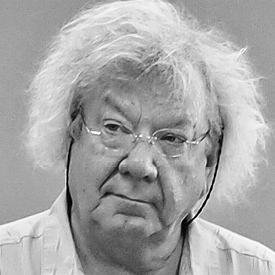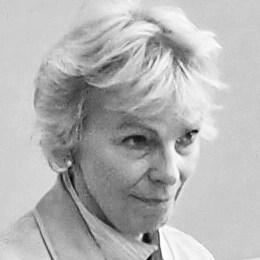Jurors' Comments
on the Final Assessment
審査講評 本審査

Atsushi Takeda (Japan)
- Visiting Professor of Tama Art University
- Art Critic
It was shocking to me that the number of applications has decreased by 30 percent. However, the selected works at the Preliminary Slide Assessment are as excellent as those of the previous exhibition.
Selecting the Grand Prize winner was truly impressive. Especially, two works attracted all the jurors’ appreciation from the beginning of the Final Assessment. As a result, one received the Grand Prize and the other received the Gold Prize, but each juror had difficulty in deciding which should be awarded the Grand Prize. Both artists live in Japan. The artist of the Gold Prize winner is from Korea and the other of the Gold Prize is a Japanese artist. Originality in their concept and design is highly evaluated by all the jurors. At the same time, we were truly impressed by their contrasting directions of expression.
The artist of the Gold Prize winner created her work into an object and developed the object into a new solid form based on the traditional plastic arts and crafts. She succeeded in her design by unconsciously utilizing a Japanese view of nature and sense of color coming out of the art view. It is sculputuresque with dynamism in a simple form.The image of the Grand Prize winner comes from an invisible spiritual world you feel day to day. The image had the artist create this strange form and color. It is unknown object with strong vital force.
Those two works have unique expression and powerful originality in common. I think that the visitors to this exhibition will be deeply impressed with fresh and rich in content.
Among four Silver Prize winners and six Honorable Mention winners are works with remarkable originality.

William Douglas Carlson (USA)
- Glass Artist
- Endowed Professor of the Arts at University of Miam
The International Exhibition of GLASS KANAZAWA 2013 is an ongoing Exhibition documenting the evolution and aesthetic sophistication that is Contemporary Glass. With each tri-annual exhibition, we have the privilege and the responsibility to review and make critical decisions about the artistic success of these glassworks. It is indeed an honor to be a part of this international assessment process and now we share the results with the Glass community of museums, collectors, artists and the public at exhibitions across Japan. The impressive catalog documents all of the accepted works.
The issue of Contemporary Glass is indeed a diverse and complex experience. Each juror has a “point of view” that is the subjective element built upon each juror’s cultural context and background. We all are different in what we find visually successful. The first review of the works is evaluated with this subjective insight.
As this assessment process continues we evolve toward an objective approach scrutinizing the craft and expertise with the artist’s interpretation in process and concept. In some cases the best craft or most exquisite piece may not be the selected work as we search for those unique qualities that explore new and imaginative understandings of Glass.
This is the point in the process we commit considerable time to discuss the qualities of the work. Nothing is easy and no decisions are made quickly as we all have an opportunity to investigate and understand the issues with an open mind and broad overview of the entire exhibition.
GLASS KANASAWA 2013 utilized all of our background expertise and professional concentration. Eventually the award winners receive broad support and are agreed upon, but the ranking of which award would go to which piece was far more difficult. Numerous votes and considerable discussion finally resolved the awards and completes the assessment process. This year’s top prize awards went to works that were inspired by nature. Their Glass inspiration focuses on plants and growth, translating that phenomenon that happens naturally with their creative studio process.
With the final tally on the Exhibit we all agreed that the artists had been successful and we had evaluated an excellent representation for the State of the Glass 2013.
The truly personal and subjective part of the assessment process is the individual Juror’s award. This is the opportunity to recognize a work of special note. My Award went to Rei Chikaoka, for “Loophole” an elegant work that almost defies gravity and floats with the feathery touch of the viewer’s gaze.
It has been an honor to share in this event and select the most important Glass for KANAZAWA 2013.

Bodil Busk Laursen (Denmark)
- Glass Critic
- Chairperson of Hempel Glass Museum
- Former Director of Designmuseum
First of all, it is very important for me to express my sincere thanks for the opportunity to become a juror at The International Exhibition of Glass Kanazawa 2013. I have learned a lot during our sessions, and I shall never forget my very first view of all the artworks exhibited for the final assessment jurors, I was moved meeting the beauty and variety of the contesting works coming from all over the world. It was easily to see that the task of selecting the prize winners would be a difficult one but also a very awarding experience, and so it turned out to be. I should like to stress how inspiring and awesome especially the pieces crafted by the Japanese artists were to me, and it became obvious that the prize winners should be elected among that group of participants. It was a very challenging and emotional journey to go through all the works and appraise the technical skills as well as the artistic quality, the soul of the individual piece. As can be seen in the report of the final assessment the quality of the work in general is very good and that of the prize winners excellent.
Coming from Europe, from Denmark, I was pleased that there were five Danish artists chosen for the final assessment, and I hope that many glass artists from countries and regions around the world will participate in future International Exhibitions of Glass Kanazawa. It is a very great opportunity for glass artists to take part in international competitions, and I would like to stress the importance of the great work performed by the organizers, The Executive Committee with representatives from Ishikawa and Kanazawa and the many devoted persons that made The International Exhibition of Glass Kanazawa 2013 a memorable event for promoting the art of glass.

Naoto Yokoyama (Japan)
- Glass Artist
The Grand and Gold Prize winners received the high scores from all the jurors at the beginning of our Final Assessment although many of the selected works are excellent. I admire their completely different stance as artistic expressionists. In coming across them, I got a flavor of what the world glass trend might be.
The Grand Prize winner, “Shape of Emotion” by KANG Min Haeng (Korea), made me feel that the artist has no interest in emotional beauty, but strongly pursued her own form and color. It expresses a wild feeling of vitality and seizes hold of my soul. Her work received the Grand Prize due to her appealing originality.
The Gold Prize goes to “A Flowery Shine” by TSUKADA Midori (Japan). It looks like a vessel, but it was developed into a new solid form based on contemporary interpretation of glass. Its impressive appearance in larger scale also expresses her creativity. The beautiful expression of the surface of the work by delicate but free cutting techniques represents Japanese fine art. It has both sculpturesque beauty and craftsmanship. I think that this work represents one direction of contemporary glass art in Japan.
The Silver Prize winner, “My Parallel Biology by DAM Steffen (Denmark), is a charming work. The artist’s sophisticated techniques and refreshed artistic expressions sublimated realistic marine creatures in a work of art.
Another Silver Prize winner, “Sunset in the Wave” by KIM Joon Yong (Korea), is a sculpturesque work. The artist created this vessel-like form with his engraving techniques.
I selected “Surface and Light” by UENO Tsukasa (Japan) for the Naoto Yokoyama Prize. This is a beautiful work with precise wimple patterns created with her sophisticated techniques. I expect her further development in her artistic surface expressions.
I feel satisfied with the Final Assessment because all the jurors had active discussions.

